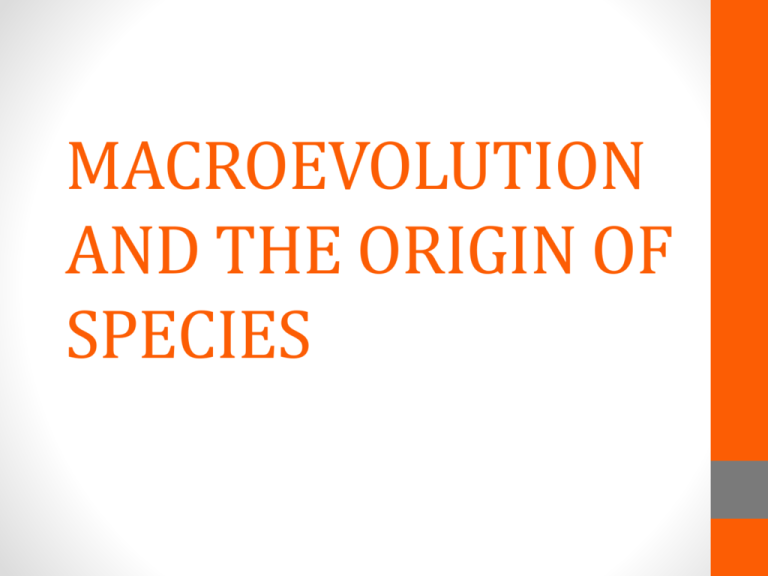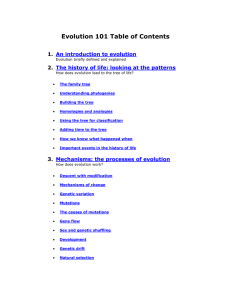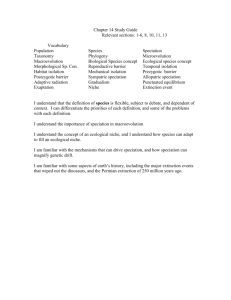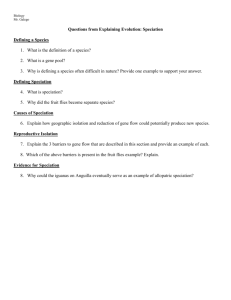Origin of Species
advertisement

MACROEVOLUTION AND THE ORIGIN OF SPECIES Origin of Species • A species is a group of organisms that can breed and produce fertile offspring together in nature. • For a new species to arise, some members of a species must become reproductively isolated from the rest of the species. This means they can no longer interbreed with other members of the species. How does this happen? Usually they become geographically isolated first. • The macroevolution of a species happens as a result of speciation. • Speciation is the branching off of individuals from the species they originally were. Over time, as natural selection occurs, individuals may build up adaptations that are no longer compatible with others in their species. This is most often due to geographic isolation or reproductive isolation from other individuals within the species. • Once the DNA is different enough, or they are no longer able to interbreed, they are now a different species that has branched off from the main species. • How quickly does this process happen? If evolution for most species takes a very long time, it would be logical to think the same would happen for speciation. However, there are two major accepted different hypotheses on the pace of evolution due to speciation. Arguments for both hypotheses are sound and there has been no evidence found so far to disprove either one. Types of Speciation Geographic Isolation Reproductive Isolation Allopatric Speciation • separated by an actual physical barrier that gets between members of a population Peripatric Speciation • extreme case of geographic isolation where only a few individuals are isolated, perhaps by some sort of disaster that kills off all but a few of the isolated population Parapatric Speciation • populations are not isolated by a physical barrier and are "beside" each other; nothing stopping the individuals in the entire population from mixing and mating, that does not happen Sympatic Speciation • individuals in the population are not separated at all and all live in the "same place". Patterns of Macroevolution Convergent Evolution • The word converge means "to come together". This pattern of macroevolution happens with distinctly different species become more similar in structure and function. Usually, this type of macroevolution is seen in different species that live in similar environments. The species are still different from one another, but they often fill the same niche in their local area. Divergent Evolution • Nearly the opposite of convergent evolution is divergent evolution. The term diverge means "to split apart". Also called adaptive radiation, this pattern is the typical example of speciation. One lineage breaks into two or more separate lines that each give rise to even more species over time. Divergent evolution is caused by changes in the environment or migration to new areas. It happens particularly quickly if there are few species already living in the new area. New species will emerge to fill the available niches. Coevolution • All living things are affected by the other living organisms around them that share their environment. Many have close, symbiotic relationships. The species in these relationships tend to cause each other to evolve. If one of the species changes, then the other will also change in response so the relationship can continue. Timing of Macroevolution Gradualism Punctuated Equilibrium • gradual accumulation of adaptations over a long period of time • proposes that there were many adaptations that slowly added up over a steady, long period of time • change happens very rapidly with long periods of stability and no change in between • short period of quick, successive changes occur to cause speciation and the new species evolves suddenly because of a chance in their environment Extinction • When every individual in a population has died off, an extinction has occurred. This, obviously, ends the species and no more speciation is able to happen for that lineage. When some species die out, others tend to flourish and take over the niche the now extinct species once filled. • Many different species have gone extinct throughout history. Most famously, the dinosaurs went extinct. The extinction of the dinosaurs allowed mammals, like humans, to come into existence and thrive. However, descendants of the dinosaurs still live on today. Birds are a type of animal that branched off from the dinosaur lineage. Lesson Summary • New species arise in the process of speciation. Allopatric speciation occurs when some members of a species become geographically separated. They then evolve genetic differences. If the differences prevent them from interbreeding with the original species, a new species has evolved. Sympatric speciation occurs without geographic separation. • Coevolution occurs when species evolve together. This often happens in species that have symbiotic relationships. Examples include flowering plants and their pollinators. • Darwin thought that evolution occurs gradually. This model of evolution is called gradualism. The fossil record better supports the model of punctuated equilibrium. In this model, long periods of little change are interrupted by bursts of rapid change.









